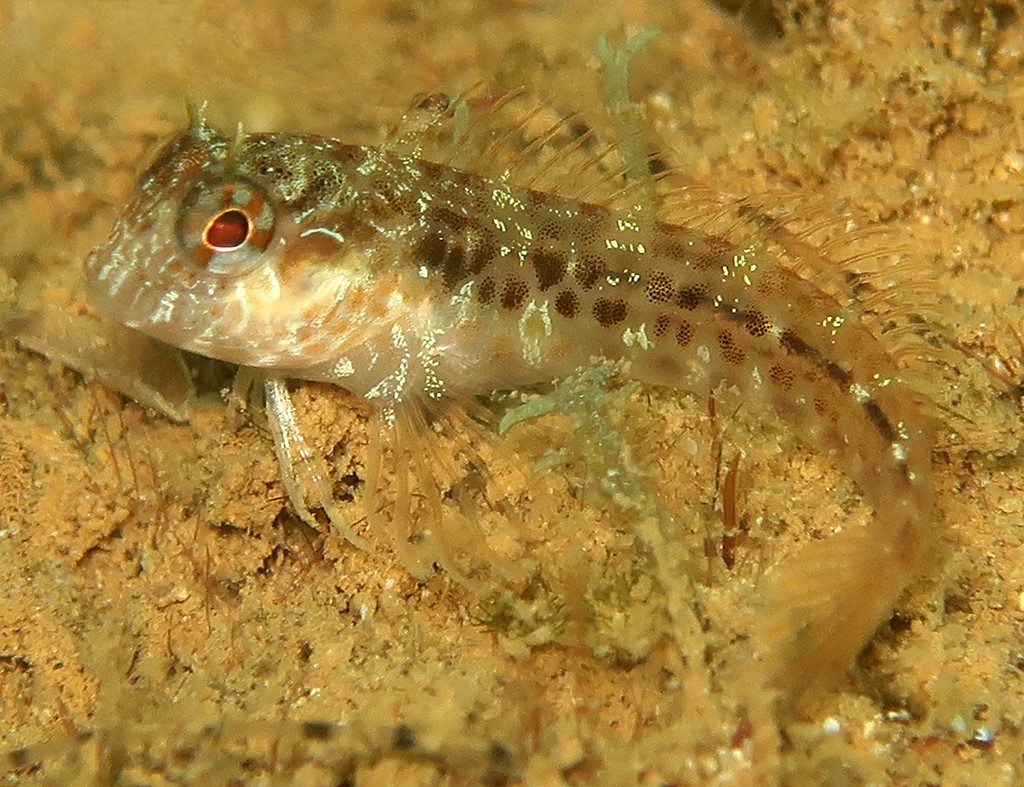PARABLENNIUS INTERMEDIUS - (OGILBY, 1915)
Picture courtesy of: Alain Daoulas
Blennie cornue, False Tasmanian blenny, Horned blenny, 間鳚, 間副鳚,
Synonymes
Blennius castaneus (Macleay, 1881)
Blennius intermedius (Ogilby, 1915)
Parablennius tasmanianus intermedius (Ogilby, 1915)
Pictiblennius intermedius (Ogilby, 1915)
Pictiblennius iredalei (Whitley, 1931)
-----------------------
Description
Dorsal spines (total): 7; Dorsal soft rays (total): 16-17; Anal spines: 2; Anal soft rays: 18-20; Pectoral fin rays: 15; Caudal fin rays: 12. Dorsal fin originating above the opercle, its border moderately cleft, the membrane of the last spine reaching about half way up the first ray; Spinous portion of the fin somewhat lower than the soft, which is highest in its third quarter, about half the length of the head; Membrane of last ray not connected with the caudal. Broad blunt snout and a multilobed tentacle above both eyes. Both jaws with strong curved canines. Lateral line distinct to about the tip of the pectoral; A few scattered pores at irregular intervals along the middle of the tail. Caudal fin rounded. Max. length: 12.0 cm TL. Depth range: 2 - 10 m.
Color
Pale greenish yellow, with 12 black spots arranged in pairs below and upon the base of the dorsal fin; Sides with numerous black spots irregularly distributed, but giving a general impression, in conjunction with the dorsal series, of vertical rows of paired spots; A few smaller spots on the sides of the abdomen and an obscure series of five along the base of the anal. Head with a few spots on the opercles and branchiostegals, and a pair of angular bars across the lower surface; Orbital cirrus black, tipped with white. A black spot between the two anterior dorsal spines and an obscure median series on the spinous portion; other fins immaculate.
Etymology
Parablennius: from Greek, para = the side of, near + from Greek, blennios = mucus. Referring to previous placement of Parablennius pilicornis in Blennius.
intermedius: from Latin prefix, inter = between + from Latin, medius = middle, mid. Referring to Darnley (or Erub) Island (Queensland, Australia, type locality), “being roughly intermediate between” Port Arthur (Tasmania) and Misaki (Japan), type localities respectively of Parablennius tasmanius and Parablennius yatabei.
Original description: Blennius intermedius Ogilby, 1915 - Type locality: Darnley Island, Torres Strait, Queensland, Australia.
Distribution
Western Pacific: Eastern and northern Australia, New Caledonia and Solomon Islands.
Biology
Adults are found in estuaries to coastal bays, often on jetty pylons. It can also be found over both dead and live coral. Feeds on a mixed diet of algae and invertebrates. Oviparous, distinct pairing. Eggs are demersal and adhesive, and are attached to the substrate via a filamentous, adhesive pad or pedestal. Larvae are planktonic, often found in shallow, coastal waters.
Similar species
Parablennius postoculomaculatus (Bath & Hutchins, 1986) - Reported from Southeastern Indian Ocean: Western Australia.
Parablennius tasmanianus (Richardson, 1842) - Reported from Southeastern Australia: Victoria, Tasmania and South Australia. Parablennius intermedius differs from Parablennius tasmanianus in possessing reddish brown to blackish spots on the head rather than fine grey stippling.
Last update: 11, June 2022
